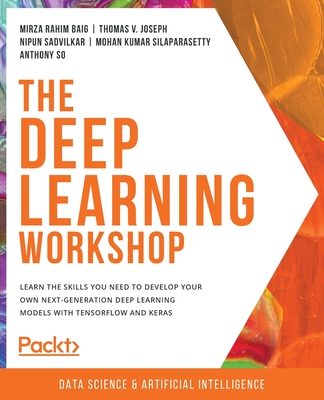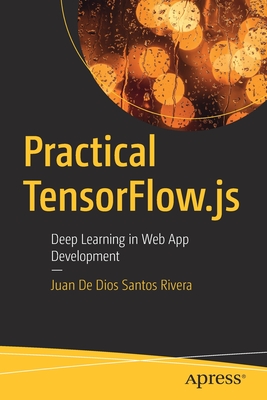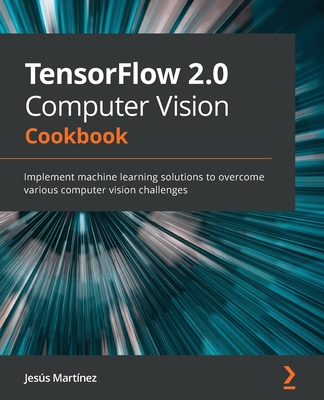Beginning Deep Learning with TensorFlow: Work with Keras, MNIST Data Sets, and Advanced Neural Networks
暫譯: 從零開始的深度學習:使用 TensorFlow、Keras、MNIST 數據集及進階神經網絡
Long, Liangqu, Zeng, Xiangming
- 出版商: Apress
- 出版日期: 2022-01-28
- 定價: $2,200
- 售價: 8.0 折 $1,760
- 語言: 英文
- 頁數: 740
- 裝訂: Quality Paper - also called trade paper
- ISBN: 148427914X
- ISBN-13: 9781484279144
-
相關分類:
DeepLearning、TensorFlow
立即出貨 (庫存 < 3)
商品描述
Incorporate deep learning into your development projects through hands-on coding and the latest versions of deep learning software, such as TensorFlow 2 and Keras. The materials used in this book are based on years of successful online education experience and feedback from thousands of online learners.
You’ll start with an introduction to AI, where you’ll learn the history of neural networks and what sets deep learning apart from other varieties of machine learning. Discovery the variety of deep learning frameworks and set-up a deep learning development environment. Next, you’ll jump into simple classification programs for hand-writing analysis. Once you’ve tackled the basics of deep learning, you move on to TensorFlow 2 specifically. Find out what exactly a Tensor is and how to work with MNIST datasets. Finally, you’ll get into the heavy lifting of programming neural networks and working with a wide variety of neural network types such as GANs and RNNs.
Deep Learning is a new area of Machine Learning research widely used in popular applications, such as voice assistant and self-driving cars. Work through the hands-on material in this book and become a TensorFlow programmer!
What You'll Learn
• Develop using deep learning algorithms
• Build deep learning models using TensorFlow 2
• Create classification systems and other, practical deep learning applications
Who This Book Is For
Students, programmers, and researchers with no experience in deep learning who want to build up their basic skillsets. Experienced machine learning programmers and engineers might also find value in updating their skills.
商品描述(中文翻譯)
將深度學習融入您的開發專案中,透過實作編碼和最新版本的深度學習軟體,如 TensorFlow 2 和 Keras。本書所使用的材料基於多年成功的線上教育經驗以及來自數千名線上學習者的反饋。
您將從人工智慧的介紹開始,了解神經網路的歷史以及深度學習與其他機器學習類型的區別。探索各種深度學習框架並設置深度學習開發環境。接下來,您將進入手寫分析的簡單分類程式。一旦掌握了深度學習的基本概念,您將專注於 TensorFlow 2。了解什麼是 Tensor 以及如何處理 MNIST 數據集。最後,您將進入編程神經網路的重點,並處理各種神經網路類型,如 GANs 和 RNNs。
深度學習是機器學習研究的一個新領域,廣泛應用於語音助手和自駕車等熱門應用中。透過本書的實作材料,成為一名 TensorFlow 程式設計師!
您將學到的內容:
• 使用深度學習演算法進行開發
• 使用 TensorFlow 2 建立深度學習模型
• 創建分類系統和其他實用的深度學習應用
本書適合對象:
對深度學習沒有經驗的學生、程式設計師和研究人員,想要建立基本技能的讀者。經驗豐富的機器學習程式設計師和工程師也可能會發現更新技能的價值。
作者簡介
Liangqu Long is a well-known deep learning educator and engineer in China. He is a successfully published author in the topic area with years of experience in teaching machine learning concepts. His two online video tutorial courses “Deep Learning with PyTorch” and “Deep Learning with TensorFlow 2” have received massive positive comments and allowed him to refine his deep learning teaching methods.
Xiangming Zeng is an experienced data scientist and machine learning practitioner. He has over ten years of experience using machine learning and deep learning models to solve real world problems in both academia and professionally. Xiangming is familiar with deep learning fundamentals and mainstream machine learning libraries such as Tensorflow and scikit-learn.
作者簡介(中文翻譯)
Liangqu Long 是中國知名的深度學習教育者和工程師。他在機器學習概念的教學方面擁有多年的經驗,並成功出版了相關主題的著作。他的兩門線上視頻教程課程「使用 PyTorch 的深度學習」和「使用 TensorFlow 2 的深度學習」獲得了大量正面評價,並使他能夠精煉他的深度學習教學方法。
Xiangming Zeng 是一位經驗豐富的數據科學家和機器學習實踐者。他在學術界和專業領域中,使用機器學習和深度學習模型解決現實世界問題的經驗超過十年。Xiangming 熟悉深度學習的基本原理以及主流的機器學習庫,如 TensorFlow 和 scikit-learn。
目錄大綱
Part 1 Introduction to AI
1. Introduction
1. Artificial Intelligence
2. History of Neural Networks
3. Characteristics of Deep Learning
4. Applications of Deep Learning
5. Deep Learning Frameworks
6. Installation of Development Environment
2. Regression
2.1 Neuron Model
2.2 Optimization Methods
2.3 Hands-on Linear Models
2.4 Linear Regression
3. Classification
3.1 Hand-writing Digital Picture Dataset
3.2 Build a Classification Model
3.3 Compute the Error
3.4 Is the Problem Solved?
3.5 Nonlinear Model
3.6 Model Representation Ability
3.7 Optimization Method
3.8 Hands-on Hand-written Recognition
3.9 Summary
Part 2 Tensorflow
4. Tensorflow 2 Basics
4.1 Datatype
4.2 Numerical Precision
4.3 What is a Tensor?
4.4 Create a Tensor
4.5 Applications of Tensors
4.6 Indexing and Slicing
4.7 Dimension Change
4.8 Broadcasting
4.9 Mathematical Operations
4.10 Hands-on Forward Propagation Algorithm
5. Tensorflow 2 Pro
5.1 Aggregation and Seperation
5.2 Data Statistics
5.3 Tensor Comparison
5.4 Fill and Copy
5.5 Data Clipping
5.6 High-level Operations
5.7 Load Classic Datasets
5.8 Hands-on MNIST Dataset Practice
Part 3 Neural Networks
6. Neural Network Introduction
6.1 Perception Model
6.2 Fully-Connected Layers
6.3 Neural Networks
6.4 Activation Functions
6.5 Output Layer
6.6 Error Calculation
6.7 Neural Network Categories
6.8 Hands-on Gas Consuming Prediction
7. Backpropagation Algorithm
7.1 Derivative and Gradient
7.2 Common Properties of Derivatives
7.3 Derivatives of Activation Functions
7.4 Gradient of Loss Function
7.5 Gradient of Fully-Connected Layers
7.6 Chain Rule
7.7 Back Propagation Algorithm
7.8 Hands-on Himmelblau Function Optimization
7.9 Hands-on Back Propagation Algorithm
8. Keras Basics
8.1 Basic Functionality
8.2 Model Configuration, Training and Testing
8.3 Save and Load Models
8.4 Customized Class
8.5 Model Zoo
8.6 Metrics
8.7 Visualization
9. Overfitting
9.1 Model Capability
9.2 Overfitting and Underfitting
9.3 Split the Dataset
9.4 Model Design
9.5 Regularization
9.6 Dropout
9.7 Data Enhancement
9.8 Hands-on Overfitting
Part 4 Deep Learning Applications
10. Convolutional Neural Network
10.1 Problem of Fully-Connected Layers
10.2 Convolutional Neural Network
10.3 Convolutional Layer
10.4 Hands-on LeNet-5
10.5 Representation Learning
10.6 Gradient Propagation
10.7 Pooling Layer
10.8 BatchNorm Layer
10.9 Classical Convolutional Neural Network
10.10 Hands-on CIFRA10 and VGG13
10.11 Variations of Convolutional Neural Network
10.12 Deep Residual Network
10.13 DenseNet
10.14 Hands-on CIFAR10 and ResNet1
目錄大綱(中文翻譯)
Part 1 Introduction to AI
1. Introduction
1. Artificial Intelligence
2. History of Neural Networks
3. Characteristics of Deep Learning
4. Applications of Deep Learning
5. Deep Learning Frameworks
6. Installation of Development Environment
2. Regression
2.1 Neuron Model
2.2 Optimization Methods
2.3 Hands-on Linear Models
2.4 Linear Regression
3. Classification
3.1 Hand-writing Digital Picture Dataset
3.2 Build a Classification Model
3.3 Compute the Error
3.4 Is the Problem Solved?
3.5 Nonlinear Model
3.6 Model Representation Ability
3.7 Optimization Method
3.8 Hands-on Hand-written Recognition
3.9 Summary
Part 2 Tensorflow
4. Tensorflow 2 Basics
4.1 Datatype
4.2 Numerical Precision
4.3 What is a Tensor?
4.4 Create a Tensor
4.5 Applications of Tensors
4.6 Indexing and Slicing
4.7 Dimension Change
4.8 Broadcasting
4.9 Mathematical Operations
4.10 Hands-on Forward Propagation Algorithm
5. Tensorflow 2 Pro
5.1 Aggregation and Seperation
5.2 Data Statistics
5.3 Tensor Comparison
5.4 Fill and Copy
5.5 Data Clipping
5.6 High-level Operations
5.7 Load Classic Datasets
5.8 Hands-on MNIST Dataset Practice
Part 3 Neural Networks
6. Neural Network Introduction
6.1 Perception Model
6.2 Fully-Connected Layers
6.3 Neural Networks
6.4 Activation Functions
6.5 Output Layer
6.6 Error Calculation
6.7 Neural Network Categories
6.8 Hands-on Gas Consuming Prediction
7. Backpropagation Algorithm
7.1 Derivative and Gradient
7.2 Common Properties of Derivatives
7.3 Derivatives of Activation Functions
7.4 Gradient of Loss Function
7.5 Gradient of Fully-Connected Layers
7.6 Chain Rule
7.7 Back Propagation Algorithm
7.8 Hands-on Himmelblau Function Optimization
7.9 Hands-on Back Propagation Algorithm
8. Keras Basics
8.1 Basic Functionality
8.2 Model Configuration, Training and Testing
8.3 Save and Load Models
8.4 Customized Class
8.5 Model Zoo
8.6 Metrics
8.7 Visualization
9. Overfitting
9.1 Model Capability
9.2 Overfitting and Underfitting
9.3 Split the Dataset
9.4 Model Design
9.5 Regularization
9.6 Dropout
9.7 Data Enhancement
9.8 Hands-on Overfitting
Part 4 Deep Learning Applications
10. Convolutional Neural Network
10.1 Problem of Fully-Connected Layers
10.2 Convolutional Neural Network
10.3 Convolutional Layer
10.4 Hands-on LeNet-5
10.5 Representation Learning
10.6 Gradient Propagation
10.7 Pooling Layer
10.8 BatchNorm Layer
10.9 Classical Convolutional Neural Network
10.10 Hands-on CIFRA10 and VGG13
10.11 Variations of Convolutional Neural Network
10.12 Deep Residual Network
10.13 DenseNet
10.14 Hands-on CIFAR10 and ResNet1

























